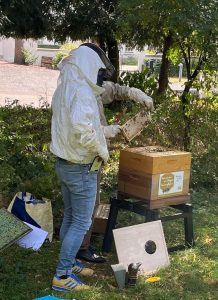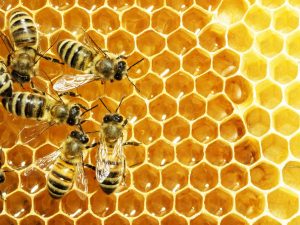The global decline in bee populations has raised alarms worldwide, and Europe is no exception.
Almost 30% of European bee species are at risk of extinction, prompting a wave of initiatives to safeguard these crucial pollinators. One such initiative is the Beehive Project, spearheaded by Daan Bijkerk, a data scientist at SAS in the Benelux region. This project merges Bijkerk’s passion for beekeeping with cutting-edge technology to address the global bee crisis.
As an avid beekeeper, Bijkerk combines his personal passion with professional expertise to lead the Beehive Project. His dedication reflects a growing movement that leverages data and technology for environmental conservation. The Beehive Project aims to protect bees and deepen our understanding of the environment and its complex connections. Through this initiative, SAS highlights its commitment to environmental stewardship, demonstrating how technology and data can be powerful tools for preserving the natural world.

"I've read so many studies on bees where experiments were conducted, but a lot of them never really got off the ground because they were so time-intensive. That’s what gave me the idea to use sensors to make the process smarter, more efficient, and less time-consuming," Bijerk said. "We know that bees communicate with each other, so I decided to install a microphone in the beehive to record their “noisy” communication. To interpret this noise, I used some transformations to analyze the data. We can already see different frequencies at different moments in time, which makes me only more curious: What are they trying to tell me?"
Introducing the Beehive Project to use data for bee conservation
In May 2024, Bijkerk began developing an AI-powered beehive advisory system. By equipping the hive with sensors connected to the SAS network, the system collects real-time data every 10 minutes. The system generates advice to the beekeeper based on various data, including internal and external temperatures, past and forecasted weather conditions, air pressure, light intensity, and audio fragments. The comprehensive data allows us to analyze and predict hive health, potentially preventing issues like Colony Collapse Disorder (CCD).
The aim is to provide an affordable, open-data solution for beekeepers and researchers to monitor hives more effectively. The project consists of two steps. First, data from the sensors at the hive, along with loggings from the beekeepers using the mobile app, are sent to a message broker (collecting and passing on all the messages). Second, the SAS environment processes this data, enriching it with additional labels generated through modeling techniques. The data collection continues independently of SAS, ensuring that the raw data remains publicly accessible.
We encourage the public to use either the enriched data from SAS or the raw data directly from the message broker. The latter can be accessed in real time via any compatible third-party message broker software, promoting widespread access and collaboration.
The technology behind the Beehive Project
The project leverages several SAS technologies:
- SAS® Event Stream Processing: Captures and transmits real-time data.
- SAS® Cloud Analytic Services (CAS): Stores and processes hive data.
- SAS® Visual Analytics: Visualizes data insights on user-friendly dashboards
Key features include:
- Temperature anomaly alerts.
- Historical event overviews.
- Predictive models for hive health.
- Behavioral and state labeling of hives.
Bijkerk comments, “The SAS Beehive monitoring device is now accessible to beekeepers and is easy to install, requiring only an internet connection via Wi-Fi, with the potential for future support of LoRa technology for much longer transmission ranges. The device also includes charging capabilities, reducing maintenance needs once it is out of the testing phase.
Bijerk adds, "The beekeeping community uses various types of hives, making it essential to gather comparable data for effective analysis. To achieve this, they must annotate the data in real time, allowing for standardization and improved comparison later on."
Another initial challenge is that the microphone inside the beehive is enclosed in a box with holes. Bees wanted to seal the holes, so our audio signal disappeared after a while. After some adjustments (a box with slots), we solved this problem. This is a nice example of “only by doing do you discover.”
Despite these initial hurdles, the project is progressing. Bijkerk feels empowered by the team's knowledge and the resources available within SAS to move the project forward. The team continues to refine the monitoring devices and expand their capabilities, including potential additions like humidity and light sensors. Collaborations with other researchers and initiatives worldwide ensure a robust and innovative approach to bee conservation.
What are some future developments?
Future plans involve integrating computer vision with the current sensor data from the beehive. This will allow us to develop a real-time learning model that analyzes what’s happening using advanced inputs, like visual data.
"My vision is to provide beekeepers with localized flora data through an app or dashboard, combining data streams from sensors and insights gathered from machine learning and AI models to deliver a comprehensive view," says Bijerk.
Our ambition is to combine detailed, resource-intensive monitoring with simpler, more efficient systems. By using real-time sensor data from the beehives, we can study bee behavior and integrate this into less frequent checks (every 10 minutes). This helps reduce the need for constant monitoring, which is expensive and uses a lot of energy. The simpler monitoring only measures things like temperature, sound, and humidity for short periods, saving power and processing time.
Bijerk explains, "We connect minimal and intensive monitoring. Patterns identified through complex models, like computer vision, are translated into simpler systems, enhancing affordable and scalable monitoring with insights from in-depth analysis."
By the end of next year, Bijerk hopes to make accurate predictions about bee swarming, determine whether the queen is present and assess the queen's health and overall performance.
Engaging the public

During our work on the project, Bijerk said they discovered that the public had limited knowledge about beehives (often thinking, "Let’s keep our distance; they might sting!").
At SAS, we value curiosity, which sparked the question: How can we ignite citizens' curiosity to learn about bees? The answer came in the form of a QR code placed on the beehive. By scanning the code, citizens can access the beehive's current status,
sensor readings, and a weekly update on the bees’ well-being.
We aim to foster greater public engagement and enhance understanding of the crucial role bees play in our ecosystem. After all, our survival is intertwined with theirs- we need each other!
More information
In the next blog, we’ll update you on project developments and aim to create a webpage where you can track the beehive's progress yourself, including its behaviors, temperatures, weather influences, and surroundings.
Check out other Data for Good projects that SAS supports.